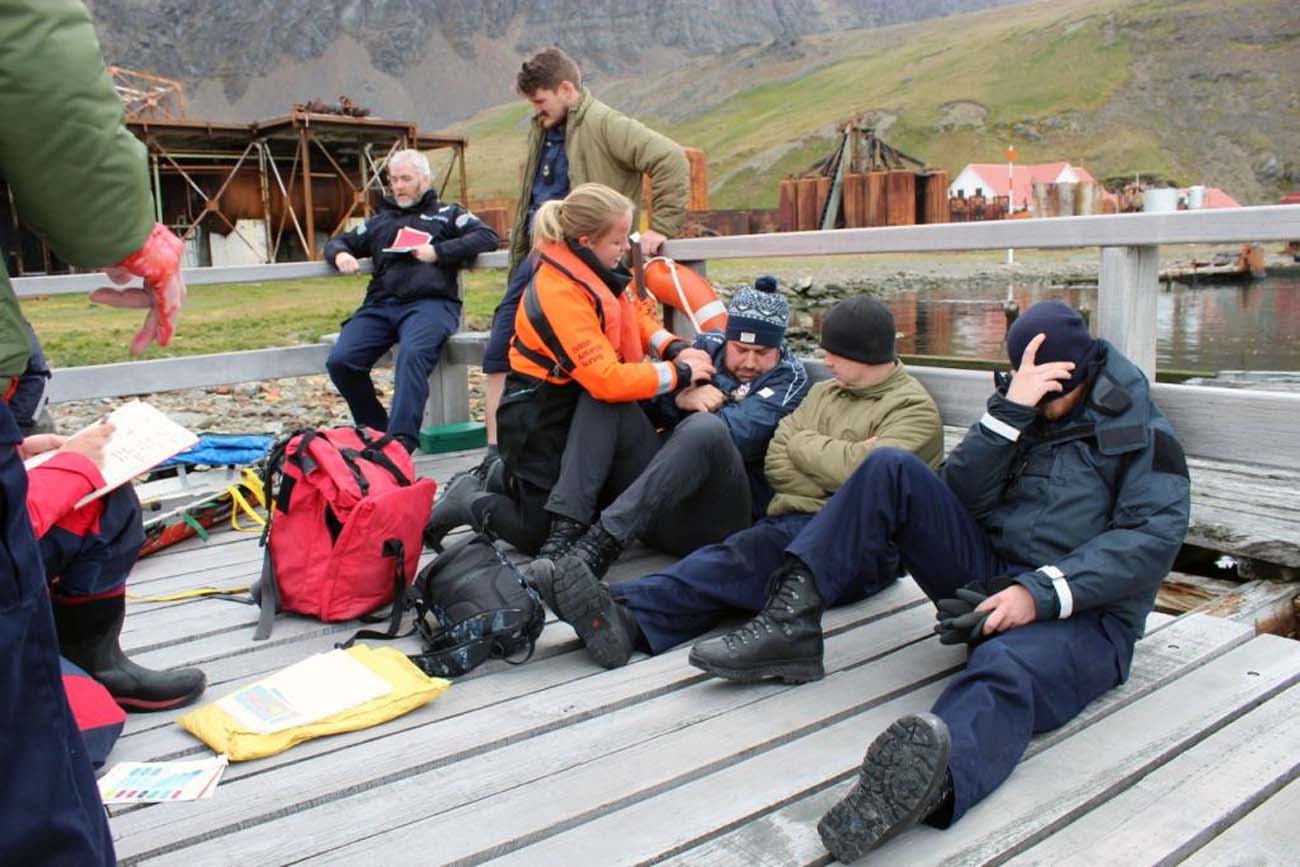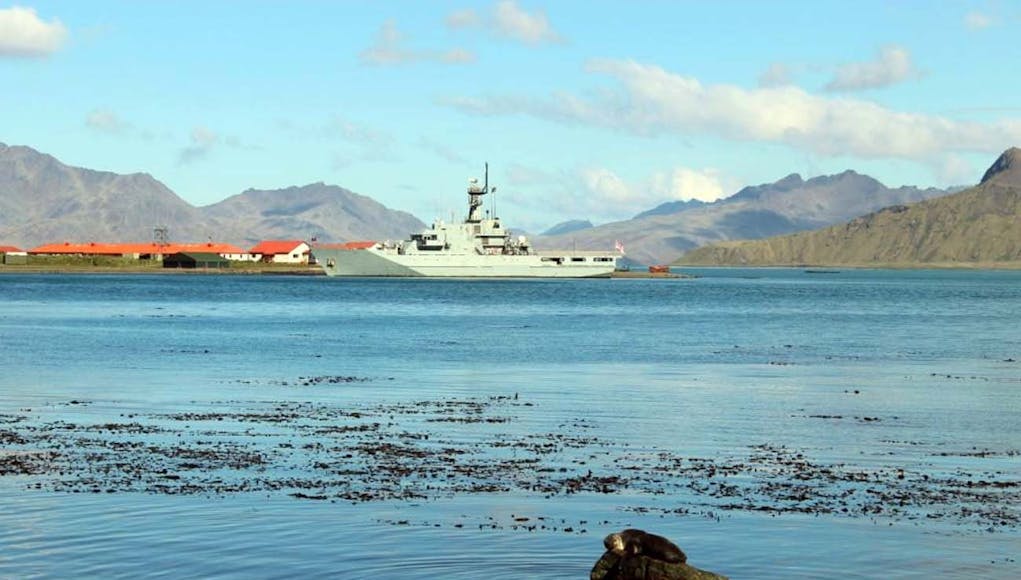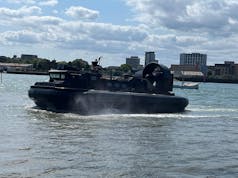HMS Clyde recently arrived in South Georgia for a mass casualty exercise, say the Royal Navy.
To keep their skills up to speed, Falklands patrol ship HMS Clyde rocked up as a stricken cruise liner with 20 ‘casualties’ after a fire according to a release. Leading Medical Assistant Will Randall transformed his shipmates into bloodied, broken and traumatised ‘passengers’.
Lt Cdr Peter Barfoot said:
“With many sailors trained for such occurrences, we were able to advise on a number of lessons which they will incorporate into their reaction plans for the future.”
According to the press release:
“Only around 30 people live on the South Atlantic island, which lies over 800 miles east of the Falklands, but during the Austral summer it is regularly visited by cruise ships carrying tourists keen to soak up Antarctic history, pay homage at Shackleton’s grave and wander around the abandoned whaling station.
There’s no hospital on South Georgia, no airfield and it’s beyond helicopter range so apart from the doctor who tends to the needs of the British Antarctic Survey team on the island – 22 scientists in the summer, a dozen in the winter – which monitors the rich wildlife.”

It was recently revealed that HMS Clyde will be replaced by one of the new Offshore Patrol Vessels currently under construction in Glasgow.
HMS Clyde was constructed to replace the Castle class patrol vessels for duties around the South Atlantic and the Falkland Islands. Clyde incorporates an extended length hull, a 30 mm cannon, two miniguns and mountings for five general purpose machine guns. The elongated hull permits a flight deck able to accommodate a Merlin sized helicopter.
The Strategic Defence and Security Review in 2015 announced a further purchase of two new Batch 2 River class ships, in addition to the three already ordered. The three Batch 1 ships without flight decks will be withdrawn in favour of the newer ships.
During a Defence Select Committee in July 2016, the First Sea Lord Admiral Sir Philip Andrew Jones indicated that the option for a fleet of ‘up to six’ offshore patrol vessels had been reduced to five, with Clyde being replaced by one of the new Batch 2 ships.
The First Sea Lord also elaborated on the potential uses for the Batch 2 ships overseas, including the possibility of forward basing an extra ship at the Falklands Islands, or forward basing it elsewhere. Admiral Sir Philip Jones said:
“Well, you are absolutely right that they have proved enormously useful, flexible and reliable ships. There are four vessels that we have in service at the moment. Three are Tyne, Mersey and Severn, which operate largely in UK waters on fishery protection and offshore tapestry protection, and of course they are increasingly working with the Border Force and the Maritime and Coastguard Agency in support of protection of UK waters. Then we have a fourth one, which is permanently based in the South Atlantic.

We have had those ships in service for quite some time now. We are looking at replacing them with slightly larger and more capable ships in due course anyway, so that was already in the course of production to bring three of those in. The additional two will enable us to take a longer term view of how we replace HMS Clyde, which is a slightly larger helicopter-capable version of the OPV. We are looking at a number of ways in which we might use the fifth one.
So, the fourth one is clearly a Clyde replacement.
The fifth one can either be added into the mix for the three that operate in UK waters or it could be forward-deployed somewhere else in the world, or it could become a second vessel operating in the South Atlantic. All those options are available.”
The new ships are different in appearance and capabilities to the Batch 1. Notable differences include their longer hull, higher top speed, Merlin capable flight deck and greatly expanded capacity for accommodating troops.














One or two of the batch 1 river class ships might prove a useful addition to the Border Force Cutters and inshore patrol boats.
The batch 2 rivers are a big improvement on their predecessors, with room for further incremental weapon and other developments in future.
https://www.thinkdefence.co.uk/2016/06/thoughts-batch-2-river-class/
If HMG gave a monkeys about illegal immigration and security of our waters, especially the channel, these batch 1’s would be retained for use by HM Coast Guard.
I would like to see the Coast Guard expanded and given a greater role alike the USCG.
It’s whistling in the wind though and the channel, our ports, and Calais will continue to be as effective as a sieve.
HMG Coast Guard are responsible for search and rescue with a fleet of helicopters and a couple of light aircraft. The UK Border Force are responsible for immigration control, law enforcement etc and operate 10 cutters and coastal patrol vessels.
Here is some pictures of the border force cutter Seeker.
http://northumbrianimages.blogspot.co.uk/2017/09/border-force-cutter-seeker-on-tyne.html
Happy to be corrected Jack.
Barely just over 10 years service and being withdrawn to be sold for peanuts. When will the waste end. However, big the budget the MOD just like the NHS will blow the lot and say they need more.
Clyde joined the fleet in 2006 which is more than 10 years ago and will have a few more to go before being replaced. Because of the age of the B1 vessels they should have a decent resale value. The batch 2 rivers are superior vessels in many ways and will be of greater use to the RN.
Jack she was commissioned in 2007 so just over 10 years service. We are just about to sell an albeit older LPH for £84m what do you think we will get for an OPV? It will be peanuts you can be sure of that. What will the Batch 2 Rivers provide that Clyde can’t in the Falklands? Abosolutely nothing is your answer just more MOD waste.
Clyde was commissioned in 2007 and this type of vessel are cheap to build and operate. Countries that will be looking at her will be poor such as Bangladesh so she will be sold for very little.
The R2s are better ships but have come at a huge cost and are replacing ships that were cheap and had years of use left in them. We could have had a couple of Type 31 frigates for the price we have paid. Overall a very bad deal for the UK taxpayer because we couldn’t design and build a frigate in the required timescale.
Always have thought the Batch 1 vessels should be retained for use in UK waters, and the five batch 2 vessels used overseas as and when seen fit. As vastly more capable vessels, they’d be better suited for this role – roles where a frigate isn’t a necessity.
A few thoughts on B2 placements:
– Falklands / South Atlantic duties
– At least one also permanently in the Caribbean for anti- narcotic operations, and to be able to provide some direct assistance alongside RFA vessel(s) during hurricane season
– One in Gib and / or Bahrain. Batch 2 vessels are far too large for operations in Gibraltars waters, and the current vessels are best suited for that role. But Gib would provide port facilities for wider operations in the Med
Then, as the T31e comes online, retire the Batch 1s. The only real issue surrounding the retention of the Batch 1’s is manpower – but with the concerns over illegal immigration, debate fishing grounds post Brexit, and only a few boarder force cutters comparative to the amount of coastline we have, it is imperative to address manpower concerns and retain sufficient capability in this field.